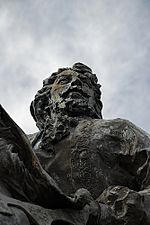Francisco Cuervo y Valdés facts for kids
Quick facts for kids
Francisco Cuervo y Valdés
|
|
|---|---|

Francisco Cuervo y Valdés
|
|
| 18th Governor of Nuevo León | |
| In office 1687–1688 |
|
| Preceded by | Antonio de Echevérez y Subiza |
| Succeeded by | Pedro Fernández de la Ventosa |
| 3rd Governor of Texas and 5th of Coahuila | |
| In office 1698 – 1702 (Texas) / 1703 (coahuila) |
|
| Preceded by | Gregorio de Salinas Varona |
| Succeeded by | Mathias de Aguirre |
| 34th Spanish Governor of New Mexico | |
| In office June 1705 – August 1707 |
|
| Preceded by | Juan Páez Hurtado |
| Succeeded by | Jose Chacón Medina Salazar y Villaseñor |
| Personal details | |
| Born | June 16, 1651 Asturias, Spain |
| Died | 1714 (62 or 63 years old) Mexico City, New Spain |
| Profession | Politician |
| Signature |  |
Francisco Cuervo y Valdés (born June 16, 1651 – died 1714) was an important Spanish politician. He served as a governor in several areas of New Spain (which is now Mexico and parts of the United States). These areas included Nuevo León, Nueva Extremadura, New Philippines, and New Mexico.
Contents
Early Life and Moving to New Spain
Francisco Cuervo y Valdés was born on June 16, 1651. His birthplace was Santa María de Grado in Asturias, Spain. His family was from a noble background, meaning they had a high social rank.
Cuervo y Valdés was a Knight of Santiago. This was a special military and religious order. He also worked as a treasury official in Guadalajara, Spain. In 1678, he moved across the ocean to New Spain. This area is now known as Mexico.
His Career as a Governor
When Cuervo y Valdés arrived in New Spain, he first worked as an infantry captain. An infantry captain leads soldiers who fight on foot. Later, he became the lieutenant governor of Sonora.
In 1698, he served as lieutenant governor for Nuevo León and Coahuila. These areas are in modern Mexico. From 1698 to 1702, he was the third governor of Spanish Texas.
Founding Missions in Texas
During his time as governor, Cuervo y Valdés helped to start several missions. Missions were settlements built by the Spanish to spread their religion and culture.
Here are some of the missions founded during his leadership:
- San Antonio Galindo Moctezuma (October 26, 1698)
- San Felipe Valladares (November 1698)
- Valle de San Bartolome de Jesus (later called "Santísimo Nombre de Jesus de los Peyotes") (December 18, 1698)
- San Juan Bautista and Valle of Santo Domingo (1699)
- Mission of San Francisco de Solano (1700)
- Nuestra Señora de Guadalupe and Santo Cristo (1701)
- Mission of San Bernardo (1703)
Governing New Mexico
In 1704, Cuervo y Valdés was chosen to be the acting governor of New Mexico. He was appointed by the Viceroy of New Spain. A viceroy was like a king's representative in a colony. The viceroy at the time was Francisco Fernández de la Cueva Enríquez, Duke of Alburquerque.
Cuervo y Valdés left his role in Coahuila and became governor of New Mexico on March 10, 1705.
Challenges in New Mexico
When he arrived, New Mexico was facing many problems. There was a continuous war between the Apaches and the Navajos against the Spanish settlers and the Pueblos. The Pueblos were allied with the Spanish.
Cuervo y Valdés led his troops against the Apaches. However, he did not have enough soldiers to protect the area well. He wrote to the Viceroy asking for more help, but his request was not granted. He then asked the Pueblo people for their help, and they agreed to join his troops.
His soldiers also needed supplies like weapons, ammunition, and clothing. He asked the viceroy for these items again. Only a small amount of weapons and ammunition was sent to New Mexico.
Founding Albuquerque
On April 23, 1706, Cuervo y Valdés founded a new town. He named it La Villa Real de San Francisco de Alburquerque. This town is now known as Albuquerque. He named it to honor the Viceroy of New Spain.
Cuervo y Valdés ordered a Spanish military group to be stationed in the new town. At that time, about thirty to thirty-five families lived in Albuquerque. They had settled along the banks of the Rio Grande river.
Cuervo y Valdés also helped to rebuild other towns in New Mexico. One example is Santa Maria de Galisteo. This town was previously known as Santa Cruz. About eighteen families from Tanos lived there. He finished his term as governor in 1707.
Later Life
After leaving his role as governor, Cuervo y Valdés returned to Mexico City. He passed away in 1714.
Personal Life
Francisco Cuervo y Valdés was married to María Francisca. They had two children together. Their children were named Francisco Antonio Cuervo and Ana María Cuervo.
Images for kids
See also
 In Spanish: Francisco Cuervo y Valdez para niños
In Spanish: Francisco Cuervo y Valdez para niños


